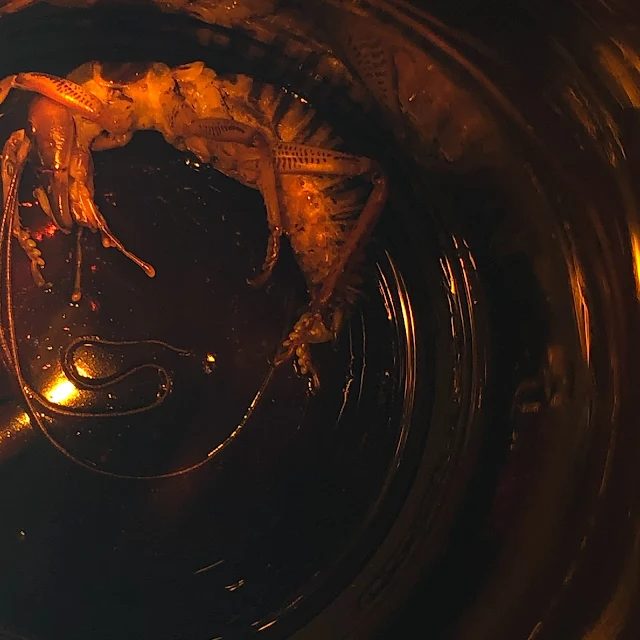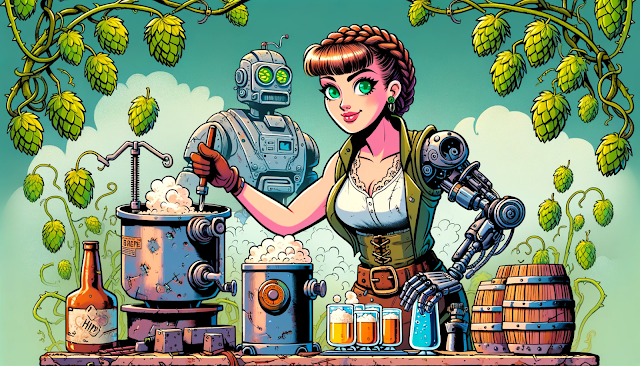Calibration essentially teaches the meter the current response characteristics of the electrode by comparing its readings to the known
pH values of buffer solutions. For brewing, it is essential to calibrate with at least two buffer solutions that bracket the expected pH range of the wort, typically pH 4.0 and pH 7.0.
This two-point calibration establishes a more accurate response curve for the meter within the acidic range relevant to brewing (around pH 5.2-5.6 for mash). While some brewers may opt for a three-point calibration that includes pH 10.0, calibrating with pH 4.0 and 7.0 is generally sufficient for most brewing applications, ensuring optimal accuracy in the pH values of most interest.
To perform calibration, you will need a few key calibration solutions and tools.
pH Meter Calibration and Maintenance Essentials
pH Buffer Solutions:
- pH 4.0
- pH 7.0
- Potentially pH 10.0
Storage Solution for pH Probe
Rinsing Solution:
- Distilled water
- Reverse osmosis (RO) water
Minimizing Waste:- Use small syringes to dispense calibration solutions into clean containers for calibration to avoid waste.
It is crucial to handle and store calibration solutions properly to prevent contamination and degradation, which can compromise their accuracy. Once opened, calibration buffers, especially those with a pH above 7.0, have a limited shelf life and should be replaced regularly to ensure accurate calibration.
The question of how often to calibrate often arises. For optimal accuracy, especially if you brew infrequently, it is recommended to calibrate your pH meter before each brew day.
Experienced brewers who brew more frequently and use a stable meter might be able to calibrate every few batches, depending on the meter's performance.
However, certain situations necessitate recalibration, such as after the meter has been used to measure strong acids or bases, or if it has not been used for an extended period. The frequency ultimately depends on the level of accuracy required, the types of samples being measured, and the stability of the specific electrode being used.

Section 4: Maintaining Your pH Meter
Proper maintenance is essential for prolonging the life of your pH meter and ensuring its accuracy over time.
Neglecting maintenance can lead to premature probe failure and unreliable readings.
Proper storage is paramount for the health of the pH electrode. When not in use, the probe should always be stored in a pH electrode storage solution, which is typically a potassium chloride (KCl) solution. This solution keeps the glass membrane of the electrode hydrated, which is crucial for its proper function.
As a temporary measure, if storage solution is unavailable, the probe can be stored in a pH 4.0 buffer solution.
However, it is critical to never store the probe in distilled or deionized water, as this can damage the electrode by causing essential ions to leach out of the internal reference solution. In addition to proper storage, it is advisable to clean the pH probe after every use to remove any buildup of yeast, sugars, or other organic matter that can interfere with readings.
To further prolong probe life, several practices should be followed.
Always rinse the probe with distilled water after each measurement to remove any residual sample. Avoid touching the electrode's glass bulb with your fingers, as oils and residues can affect pH readings. Do not use harsh chemicals or abrasive cleaning methods that could damage the delicate glass membrane.
If you notice protein or
mineral buildup on the probe, consider using specific pH electrode cleaning solutions designed for these types of contaminants. For instance, enzymatic cleaning solutions can effectively remove protein deposits from wort.
Perhaps the most critical step in prolonging probe life is to always measure cooled wort samples. Exposing the probe to high temperatures can significantly shorten its lifespan and may even lead to inaccurate readings.
Even with the best care,
pH probes have a finite lifespan and will eventually need replacement. Be aware of the signs that your probe needs replacing.
These include inconsistent readings, the meter frequently failing to calibrate, and a noticeable slowing of the response time when taking measurements. While the typical lifespan of a pH probe for homebrewing is around one to two years, this can vary depending on the frequency of use and the level of care provided.

Section 5: Choosing the Right pH Meter for Your Brewing
Setup
The
market offers a wide array of pH meters, catering to various budgets and levels of brewing expertise. Understanding the trade-offs between price and features is crucial when selecting the right meter for your needs.
The spectrum of available pH meters ranges from budget-friendly options to more professional-grade instruments.
Models like the
Kegland pH Meter represent the more affordable end, often offering features like 0.01 pH resolution, automatic temperature compensation (ATC), and replaceable probes.
While generally providing good value, some users have reported issues with these types of meters drifting or experiencing calibration problems.
Stepping up in quality and price, the
Milwaukee MW102 is a popular choice among homebrewers, known for its reliability and accuracy (typically ±0.02 pH). It features 0.01 pH resolution, ATC, a separate temperature probe, and a replaceable electrode.
For those seeking higher accuracy, the
Hanna Phep 5 (HI98128) offers 0.01 pH resolution, ±0.05 pH accuracy, ATC, a replaceable electrode, and a waterproof design. Apera Instruments have also gained a positive reputation among homebrewers for their accuracy and value, with models like the AI209 and PH60 (AI311) offering features like 0.01 pH resolution and replaceable probes on some models.
The
Bluelab Combo Meter is known for its reliability, accuracy, and ability to maintain calibration, also featuring a replaceable probe.
The primary trade-offs between budget and quality often revolve around accuracy, resolution, the presence of ATC, and whether the probe is replaceable.
For serious homebrewers aiming for consistent and high-quality results, investing in a meter with at least 0.01 pH resolution and a replaceable probe is generally recommended.
The ability to replace the probe not only extends the lifespan of the meter but also proves more cost-effective in the long run as probes inevitably degrade over time.
Based on experience, the recommendation for choosing a pH meter often depends on the brewer's level of involvement and desired precision.
For brewers just starting out or those primarily concerned with ensuring their mash pH falls within the general acceptable range,
a simple pen-style meter might suffice.

Section 6: pH Test Strips vs. pH Meters
Homebrewers have two primary options for measuring pH: pH test strips and pH meters. While test strips might seem like a more convenient and affordable option, pH meters offer significant advantages, particularly when it comes to accuracy.
pH meters are generally superior to test strips for brewing due to several key factors. The most significant drawback of pH test strips is their lower accuracy, typically providing readings within a range of ±0.5 to 1 pH unit.
This level of imprecision is often insufficient for making the fine adjustments needed in brewing, especially during the critical mashing stage. Reading the color changes on test strips can also be subjective and challenging, especially in colored wort, leading to potential errors in interpretation.
Furthermore, most pH test strips lack temperature compensation, meaning their accuracy can be affected by the temperature of the sample being tested. In contrast, pH meters offer much higher precision, typically with a resolution of 0.01
pH.
They provide a rapid digital readout, eliminating the subjectivity of color matching, and many models include automatic temperature compensation for more accurate readings.
While pH meters are generally the preferred choice for precise brewing measurements, there might be rare occasions when pH strips could be used.
For instance, test strips might suffice for a very quick, rough check, such as verifying that a sanitizer solution falls within a general pH range.
However, for any measurement where accuracy is important, particularly for mash pH, a pH meter is the only reliable option.
The subtle color differences on pH strips, especially within the critical pH 5.0–5.5 range for mashing, can easily mislead brewers, leading to incorrect assumptions about their mash pH. Relying on color matching introduces subjectivity and potential for error, particularly for individuals with color vision deficiencies or under varying lighting conditions.
Section 7: Handling Temperature Issues in pH Measurement
Temperature plays a complex role in pH measurement, affecting both the instrument and the solution being measured. Understanding these effects is crucial for obtaining accurate and meaningful pH readings in brewing.
As previously discussed, pH and temperature are intrinsically linked. Temperature influences the electrochemical response of the pH electrode. Additionally, the chemical activity of the wort itself changes with temperature, with the pH generally decreasing (becoming more acidic) as the temperature rises.
Automatic Temperature Compensation (ATC) in pH meters is designed to correct for the temperature-dependent variations in the electrode's response, ensuring the meter remains calibrated across different temperatures.
However, ATC does not compensate for the actual pH shift in the wort caused by temperature changes.
Therefore, for consistency and to allow for meaningful comparisons with published brewing data and software predictions, it is crucial to measure wort samples at a consistent temperature, ideally room temperature (around 68-77
°F or 20-25
°C).
The mash pH values reported in brewing resources are almost universally based on room temperature measurements.
When dealing with hot wort samples, such as during mashing, it is essential to follow best practices for hot wort measurements. The most important step is to cool the wort sample down to room temperature before taking a pH reading.
This can be achieved by taking a small sample of wort in a clean glass container and placing it in an ice bath or a cold water bath. Swirling the sample in the cooling bath will help expedite the process. It is crucial to avoid measuring the pH of hot wort directly at mash temperatures without cooling the sample first.
Doing so can not only lead to inaccurate readings due to the temperature-dependent pH of the wort but can also potentially damage the pH probe, shortening its lifespan.
Section 8: Common Mistakes and How to Avoid Them
Even with a good pH meter, several common mistakes can lead to inaccurate readings and frustration. Being aware of these pitfalls and knowing how to avoid them is key to mastering pH control in your homebrewery.
One frequent error is underestimating the importance of calibration. Skipping calibration steps or not calibrating frequently enough can result in unreliable readings and inconsistent brewing outcomes. Another common mistake is not storing the probe correctly.
Failing to store the probe in a proper storage solution (like KCl solution) can lead to dehydration of the electrode, significantly shortening its lifespan and affecting its accuracy. Using low-quality meters can also be a source of error.
While budget-friendly options exist, they often lack the accuracy, resolution, and durability needed for consistent brewing, leading to unreliable readings and frustration.
As discussed previously, measuring hot wort directly without cooling it to room temperature is a significant mistake that can lead to inaccurate readings and potential probe damage. Another common error is wiping the electrode with a cloth or paper towel.
This can create a static charge on the glass bulb, interfering with the reading. Rinsing with distilled water and gently blotting dry with a lint-free cloth is the preferred method. Finally, using contaminated or expired calibration buffers will undoubtedly lead to inaccurate calibration and, consequently, incorrect pH measurements.
Always
ensure your buffer solutions are fresh and have been stored properly.
Section 9: Real-World Tips from an Experienced Brewer
Monitoring pH throughout the brewing process helps you maintain consistency and control over your beer’s flavor and quality. By keeping track of pH at key points, you can ensure each batch turns out just the way you want it.
Check Strike Water pH
The pH of your strike water is crucial as it sets the foundation for your mash. After adding any mineral salts to your water, measure the pH of the strike water before combining it with the grains.
Adjusting the water's pH at this stage ensures that the mash will start at the correct acidity level, which is vital for efficient enzyme activity and overall mash performance.
Strive to hit a target pH range of 5.3–5.5, which helps achieve optimal enzyme breakdown of starches during mashing.
Monitor Mash pH Early
After doughing in, it’s essential to check the pH of your mash 15–20 minutes in. This allows enough time for the water and grains to integrate and the enzymes to begin working. Use a small sample of wort, cool it to room temperature (as temperature can skew readings), and measure the pH.
If the pH is too high or too low, make quick adjustments with lactic acid or other pH modifiers.
Keeping your mash pH between 5.2 and 5.6 is ideal for most styles, but specific beer types may require slight variations.
Test Sparge Water pH
When sparging, particularly for lighter-colored beers like pale ales or pilsners, it’s crucial to monitor the pH of the sparge water.
If the pH is too high, you risk extracting undesirable compounds like tannins from the grain husks, which can result in a harsh, astringent flavor in the finished beer.
Aim for a sparge water pH below 6.0 to avoid these off-flavors and ensure a smooth, clean taste. If necessary, adjust the sparge water’s pH by adding acid or using acidulated malt.
Pre-Boil Wort pH:
If you’ve made significant adjustments to your water profile or added large quantities of minerals, check the pH of the wort before boiling.
During this stage, the pH should ideally fall within the range of 5.1 to 5.4. This helps ensure proper hop utilization and prevents off-flavors from forming during the boil. If the pH is too low, it may be due to excessive mineral additions, while a higher pH could suggest inadequate acidulation.
Adjusting pH pre-boil allows you to correct any imbalances early.
Measure Finished Beer pH:
While the primary focus is on the brewing process itself, measuring the pH of your finished beer can offer valuable insights into the fermentation and aging process. pH plays a role in the overall stability and flavor of the beer.
A pH that’s too low can result in sharp, overly sour flavors, while a pH that’s too high can lead to off-flavors or a lack of crispness.
Monitoring pH at this stage helps you identify potential issues and guide adjustments in future batches.
Maintain a Brew Log:
Documenting your pH readings at every stage of the brewing process is one of the most effective ways to fine-tune your technique over time.
A detailed brew log lets you spot trends, such as shifts in pH due to water composition or the effects of different ingredients, and helps you replicate successful batches.
With consistent record-keeping, you’ll gain a deeper understanding of how various pH levels impact your beer and can make informed decisions to improve each brew.
Adjust for Style Profiles:
The ideal mash pH can vary depending on the beer style you're brewing. For example, hop-forward IPAs often benefit from a slightly lower mash pH (around 5.2–5.4), which helps extract and highlight hop bitterness and aroma.
In contrast, malt-driven styles like stouts and porters thrive with a slightly higher mash pH (5.4–5.6), which enhances the body and mouthfeel of the beer. Understanding the role of pH in achieving the desired flavor profile will help you tailor your brewing process for each unique style.
By carefully monitoring and adjusting pH throughout your brewing process, you take control over the key chemical reactions that shape your beer's flavor, mouthfeel, and clarity. Each batch becomes an opportunity to fine-tune your craft, ensuring your brews consistently meet your highest expectations.
initial mashing stage

















